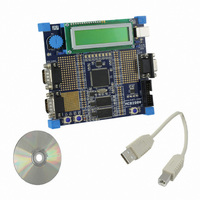OM11014 NXP Semiconductors, OM11014 Datasheet - Page 36

OM11014
Manufacturer Part Number
OM11014
Description
BOARD EVAL FOR LPC2919
Manufacturer
NXP Semiconductors
Series
Keilr
Type
MCUr
Datasheet
1.OM11014.pdf
(67 pages)
Specifications of OM11014
Contents
Board, Cable, CD
For Use With/related Products
LPC2919
Lead Free Status / RoHS Status
Not applicable / Not applicable
Other names
568-4360
NXP Semiconductors
LPC2917_19_1
Product data sheet
8.7.6.1 Overview
8.7.6.2 Description
8.7.6 PWM
The frequency of all the CLK_MSCSS_ADCx_APB clocks is identical to
CLK_MSCSS_APB since they are derived from the same base clock
BASE_MSCSS_CLK. Likewise the frequency of all the CLK_ADCx clocks is identical
since they are derived from the same base clock BASE_ADC_CLK.
The register interface towards the system bus is clocked by CLK_MSCSS_ADCx_APB.
Control logic for the analog section of the ADC is clocked by CLK_ADCx, see also
Figure
The MSCSS in the LPC2917/19 includes four PWM modules with the following features.
The ability to provide flexible waveforms allows PWM blocks to be used in multiple
applications; e.g. automotive dimmer/lamp control and fan control. Pulse-width modulation
is the preferred method for regulating power since no additional heat is generated and it is
energy-efficient when compared with linear-regulating voltage control networks.
The PWM delivers the waveforms/pulses of the desired duty cycles and cycle periods. A
very basic application of these pulses can be in controlling the amount of power
transferred to a load. Since the duty cycle of the pulses can be controlled, the desired
amount of power can be transferred for a controlled duration. Two examples of such
applications are:
•
•
•
•
•
•
•
•
•
•
•
•
Six pulse-width modulated output signals
Double edge features (rising and falling edges programmed individually)
Optional interrupt generation on match (each edge)
Different operation modes: continuous or run-once
16-bit PWM counter and 16-bit prescale counter allow a large range of PWM periods
A protective mode (TRAP) holding the output in a software-controllable state and with
optional interrupt generation on a trap event
Three capture registers and capture trigger pins with optional interrupt generation on
a capture event
Interrupt generation on match event, capture event, PWM counter overflow or trap
event
A burst mode mixing the external carrier signal with internally generated PWM
Programmable sync-delay output to trigger other PWM modules (master/slave
behavior)
Automotive dimmer controller: The flexibility of providing waves of a desired duty cycle
and cycle period allows the PWM to control the amount of power to be transferred to
the load. The PWM functions as a dimmer controller in this application
Motor controller: The PWM provides multi-phase outputs, and these outputs can be
controlled to have a certain pattern sequence. In this way the force/torque of the
motor can be adjusted as desired. This makes the PWM function as a motor drive.
9.
Rev. 01 — 31 July 2008
ARM9 microcontroller with CAN and LIN
LPC2917/19
© NXP B.V. 2008. All rights reserved.
36 of 67















